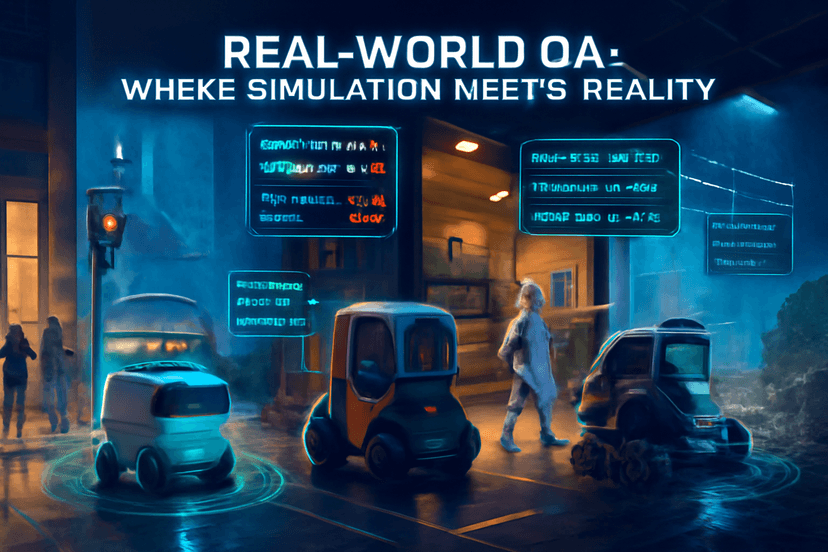Why Do Shoppers Quit at the Final Step of Buying?
Autonomous robots have moved from futuristic prototypes to everyday tools in logistics, healthcare, security, and hospitality. From warehouse AMRs to delivery drones, these machines make independent decisions, navigate obstacles, and adapt to changing conditions in real time.
But with autonomy comes complexity — and higher stakes. Testing goes beyond verifying movement; it ensures that navigation, perception, and control systems function accurately under unpredictable real-world conditions.
Why Autonomous Robot Testing Is Different
Traditional robots follow predefined paths in controlled settings. Autonomous robots, however, must interpret live sensor data, react to unexpected hazards, and adjust their actions instantly.
Testing must replicate the uncertainty of real environments — crowds, variable lighting, moving objects, or rough terrain — and confirm that the robot responds predictably and safely.
Core Areas of Autonomous Robot QA
Localization ensures the robot always knows where it is. This can involve GPS outdoors or SLAM (Simultaneous Localization and Mapping) indoors, with fallback strategies for signal loss.
Perception tests how well the robot detects and interprets its surroundings. This includes object recognition, semantic understanding, and merging data from lidar, cameras, and ultrasonic sensors.
Path Planning evaluates the robot’s ability to chart efficient, safe routes — even when encountering blocked paths or moving obstacles.
Control Systems convert plans into precise movement, maintaining stability and accuracy under varying loads and surfaces.
Fail-Safe and Recovery Validation
Robots must handle unexpected failures without creating hazards. Sensor breakdowns, blocked routes, or navigation errors should trigger safe responses — such as halting, re-routing, or returning to base.
Testing also ensures human override commands take immediate priority, providing a final safety layer.
Simulation vs. Real-World Testing
Simulation platforms like Gazebo, CARLA, and Webots help engineers explore extreme conditions — night operations, weather interference, or sensor noise — in a risk-free setting.
However, physical trials are essential to expose issues simulations cannot capture, like glare on reflective floors or hardware overheating. The best QA strategies combine both approaches.
Environmental and Terrain Testing
Robots may encounter diverse operational challenges:
- Switching from carpet to polished concrete
- Navigating wet or slippery floors
- Operating in dim corridors or bright sunlight
- Recognizing obstacles on reflective or transparent surfaces
Testing across such variables ensures reliability before deployment.
Key Metrics for Autonomous Robot QA
| Metric | Purpose | Example Target |
| Localization Error (cm) | Measures accuracy of position estimation | ≤ 5 cm indoors |
| Obstacle Detection Accuracy (%) | Validates correct identification of hazards | ≥ 95% |
| Re-planning Latency (ms) | Time to adjust route after an obstruction | ≤ 500 ms |
| Navigation Success Rate (%) | Percentage of successful point-to-point journeys | ≥ 98% |
| Battery Consumption per Meter (Wh/m) | Assesses energy efficiency during movement | ≤ 0.05 Wh/m |
| Response Time to Moving Objects (ms) | Measures reaction speed to sudden hazards | ≤ 300 ms |
Industry Use Cases and Testing Priorities
In warehouses, AMRs must maintain precision docking under load.
In hospitals, service robots navigate busy hallways without collisions.
In security, patrol bots handle low-light outdoor navigation.
In agriculture, autonomous harvesters adapt to uneven ground and plant density.
Each environment requires tailored test conditions to meet both safety and operational goals.
Continuous AI Model Validation
Many autonomous robots rely on AI that evolves over time. This demands ongoing regression testing to confirm that updates improve performance without introducing new risks.
By repeating previous test scenarios, QA teams can directly compare results and ensure consistency.
Conclusion: Smarter Testing for Smarter Robots
Autonomous robots are powerful, but only as safe and effective as their testing allows. Robust QA ensures they interpret their surroundings correctly, navigate efficiently, and react safely to unexpected challenges.
At Testriq, we combine simulation-driven stress testing with real-world scenario validation to deliver autonomous systems that perform reliably in the environments that matter most.
About Atul Ahire
Expert in Robotics Testing with years of experience in software testing and quality assurance.
Found this article helpful?
Share it with your team!
